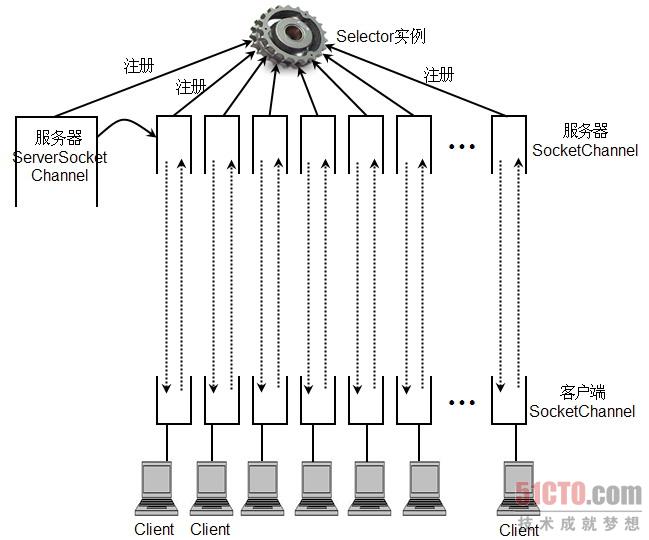 Netty系列-NIO非阻塞网络编程原理分析
Netty系列-NIO非阻塞网络编程原理分析
# Netty系列-NIO非阻塞网络编程原理分析

- 当客户端连接时会通过ServerSocketChannel得到SocketChannel。
- 将SocketChannel实例注册到Selector上
register(Selector sel, int ops, Object att)。 - 注册并返回SelectionKey,会和该Selector关联(集合)。
- Selector进行监听select()方法,返回有事件发生的通道个数。
- 进一步得到各个事件响应的SelectionKey
- 再通过SelectionKey的channel()方法获取所注册的SocketChannel
# 示例代码
@Test
public void ClientTest() throws IOException {
SocketChannel socketChannel = SocketChannel.open();
socketChannel.configureBlocking(false);
InetSocketAddress address = new InetSocketAddress("127.0.0.1", 6666);
if (!socketChannel.connect(address)) {
while (!socketChannel.finishConnect())
System.out.println("Client:连接需要时间,客户端不会阻塞");
}
String str = "Hello Server";
ByteBuffer buffer = ByteBuffer.wrap(str.getBytes());
socketChannel.write(buffer);
int read = System.in.read();
}
1
2
3
4
5
6
7
8
9
10
11
12
13
14
2
3
4
5
6
7
8
9
10
11
12
13
14
@Test
public void ServerTest() throws IOException {
//获取ServerSocketChannel实例
ServerSocketChannel serverSocketChannel = ServerSocketChannel.open();
//获取Selector实例
Selector selector = Selector.open();
//绑定IP地址和端口
serverSocketChannel.socket().bind(new InetSocketAddress(6666));
//配置为非阻塞模式
serverSocketChannel.configureBlocking(false);
//将ServerSocketChannel实例注册到Selector实例中,标识为OP_ACCEPT
serverSocketChannel.register(selector, SelectionKey.OP_ACCEPT);
while (true) {
//等待1000ms,无事件发生则返回
if (selector.select(1000) == 0) {
System.out.println("Server:等待一秒,无连接");
continue;
}
//获取有事件发生的SelectionKey集合
Set<SelectionKey> selectionKeys = selector.selectedKeys();
//遍历集合
Iterator<SelectionKey> iterator = selectionKeys.iterator();
while (iterator.hasNext()) {
SelectionKey selectionKey = iterator.next();
//如果是OP_ACCEPT,表明有客户端连接
if (selectionKey.isAcceptable()) {
//为该客户端生成SocketChannel实例
SocketChannel accept = serverSocketChannel.accept();
accept.configureBlocking(false);
//并将SocketChannel实例注册到Selector中,标识为OP_READ,并关联Buffer。
accept.register(selector, SelectionKey.OP_READ, ByteBuffer.allocate(1024));
}
//如果是OP_READ,表明客户端已经将数据写入SocketChannel实例
if (selectionKey.isReadable()) {
//获取已经变化的SocketChannel实例
SocketChannel socketChannel = (SocketChannel) selectionKey.channel();
//获取到关联的Buffer
ByteBuffer buffer = (ByteBuffer) selectionKey.attachment();
//读取数据
socketChannel.read(buffer);
System.out.println("from Cline:"+new String(buffer.array()));
}
//移除已经处理的事件,防止重复处理。
selectionKeys.remove(selectionKey);
}
}
}
1
2
3
4
5
6
7
8
9
10
11
12
13
14
15
16
17
18
19
20
21
22
23
24
25
26
27
28
29
30
31
32
33
34
35
36
37
38
39
40
41
42
43
44
45
46
47
48
2
3
4
5
6
7
8
9
10
11
12
13
14
15
16
17
18
19
20
21
22
23
24
25
26
27
28
29
30
31
32
33
34
35
36
37
38
39
40
41
42
43
44
45
46
47
48
# NIO与零拷贝
上次更新: 2020/07/25, 16:07:00
